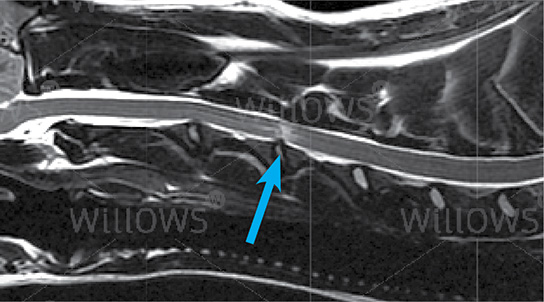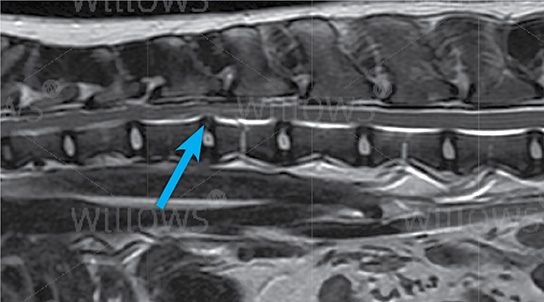Traumatic Disc Extrusion

News

Why Should I Bring my Pet to Willows a Traumatic Disc Extrusion?
Willows is one of Europe’s leading small animal referral centres. Our state-of-the-art hospital is led by internationally renowned Specialists, committed to providing the highest standards of veterinary care. Our Specialist Neurosurgeons are supported by our multi-disciplinary team of Specialists across a number of different disciplines including; Anaesthesia, Diagnostic Imaging and Emergency and Critical Care.
Willows also has a large dedicated team of Vets, Nurses and clinical support staff available 24 hours a day, every day of the year to provide the best possible care for your pet.

What is a Traumatic Disc Extrusion?
A traumatic disc extrusion (‘slipped disc’) occurs when a small fragment of material from the centre of a disc (the cushion between the bones of the spine) suddenly breaks free and travels at speed through the outer ring of the disc and collides with the spinal cord (the bundle of nerves in the spine). This type of ‘slipped disc’ is also referred to as an ‘explosive disc extrusion’.
What causes a Traumatic Disc Extrusion?
The most common causes of this injury are road traffic accidents and trauma sustained when running into objects such as trees or patio doors. However, rupture of the discs in the spine can also occur when exercising vigorously.

What are the Signs of a Traumatic Disc Extrusion?
The clinical signs depend upon the area of the spinal cord that is damaged and the extent of the injury. Patients may appear to be wobbly on their legs, lose the ability to move one or more limbs or may not be able to stand at all. Severely affected animals may be paralysed, incontinent or lose the ability to feel pain in their limbs and tail.
Injuries to the neck result in all four limbs being affected, in contrast to back injuries where only the back limbs are affected. One side of the body is often more affected than the other. In general, traumatic disc extrusions are not painful, although when the disc suddenly ruptures some patients may yelp or cry out. After the initial onset, the neurological signs do not tend to get any worse after the first 24 hours.
Fig 1: MRI scan showing a traumatic disc extrusion in the neck (arrow)


How is a Traumatic Disc Extrusion Diagnosed?
Investigations are generally required in order to diagnose traumatic disc extrusions and rule out other causes of sudden spinal injury, such as a stroke (referred to as an ischaemic myelopathy), spinal fracture or degenerative slipped disc (see our information sheets on cervical disc disease and thoracolumbar disc disease).
X-rays of the spine may show that the space where an affected disc lies looks narrower than normal, suggesting that some of the disc material has moved out of position. More advanced investigations are necessary to see if a disc has actually ruptured and to assess if it is pressing on the spinal cord. An MRI scan provides the best method of investigating this condition. MRI uses high powered magnets and a computer to generate images of the spine and provides information not only on the health and position of the discs in the spine but also on the nature of any injury to the spinal cord. This makes diagnosis more accurate and assists greatly in deciding the best course of treatment for the individual patient.
Fig 2: MRI scan showing a traumatic disc extrusion in the back (arrow)

How can a Traumatic Disc Extrusion Diagnosed be treated?
Traumatic disc extrusions generally cause spinal cord bruising rather than squashing of the spinal cord. The damage done by the bruising cannot be treated surgically, and so surgery is not usually of any value in treating the injury. Instead, the patient needs to be given time to allow the damaged nerve tissue to recover.
Supportive care and nursing after a traumatic disc extrusion are essential in order to aid recovery. Bedding needs to be well padded in order to prevent bed sores. Regular physiotherapy and, in some cases, hydrotherapy can help function to be regained and assist in building strength. Some patients may require a catheter to be placed in the bladder temporarily to aid urination.
What is the Outcome for Patients with a Traumatic Disc Extrusion?
The outcome in dogs with traumatic disc extrusions depends on many factors including the severity, nature and location of the spinal cord injury. The findings on the neurological examination and MRI scanning can help to predict the chances of recovery.
Patients that are paralysed and cannot feel pain in their limbs are, sadly, unlikely to recover. However, the majority of less severely affected animals will gradually improve over a period of weeks to months, to a point where they can freely exercise and have a good quality of life. A degree of weakness in one or more limbs and, occasionally, incontinence may persist in some patients. Recurrence of this type of disc extrusion is very uncommon.
To save this page as a PDF, click the button and make sure “Save as PDF” is selected. Print This Page
Neurology
Find out more
To assist owners in understanding more about Neurological conditions, investigations and treatment we have put together a range of information sheets to talk you through the some of the more common neurological conditions seen by our Specialists.

